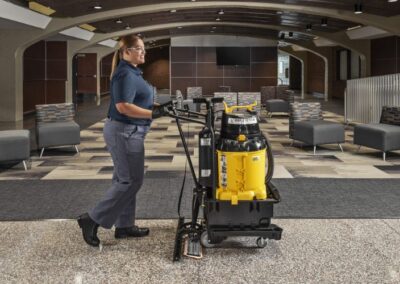
K-12 Schools & Higher Ed Articles

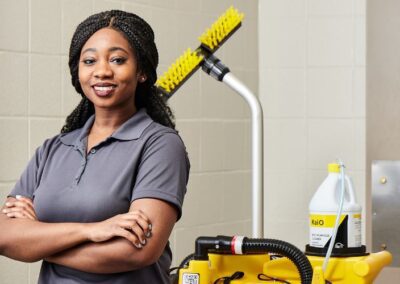
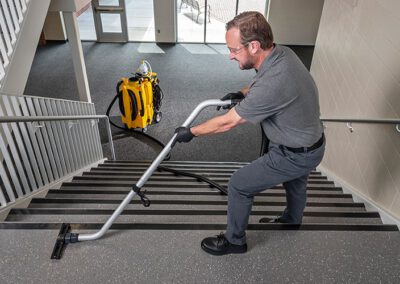
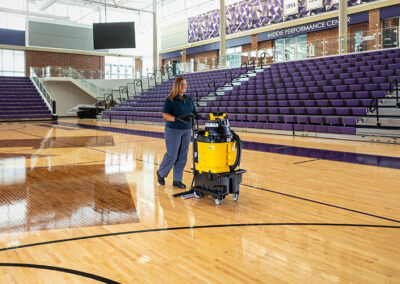

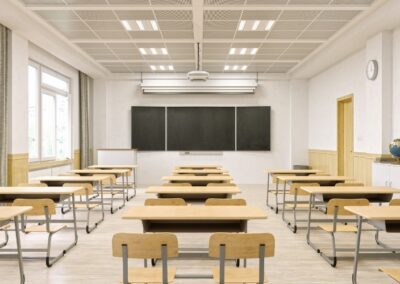
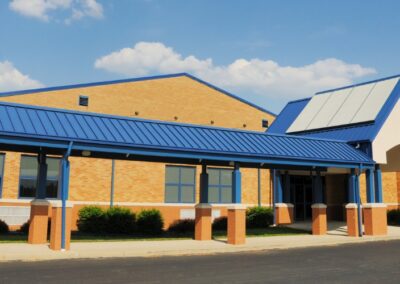
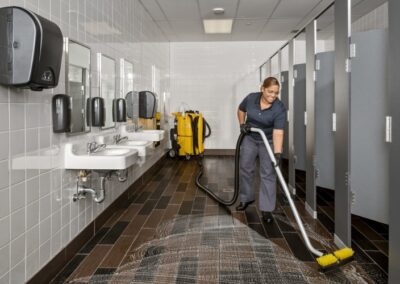
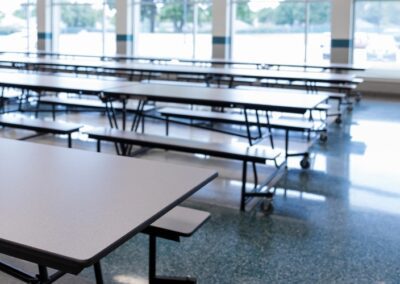
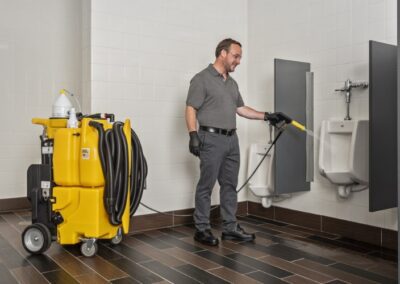
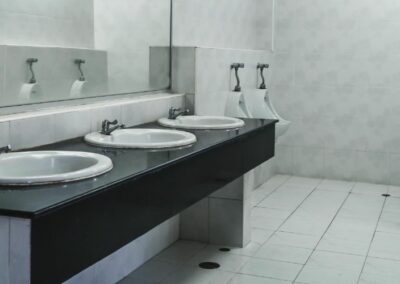
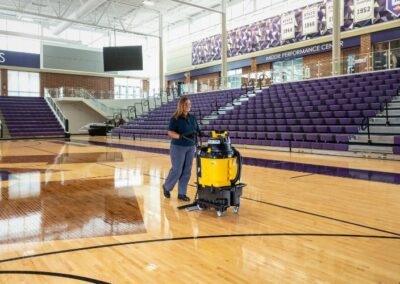












Overview: Most popular No-Touch Cleaning® system
Best For: Medium-Large Restrooms
Capacity: 17 gallon fresh water / 17 gallon vacuum tanks
Overview: Most Compact No-Touch Cleaning® system
Best For: Small-Medium Restrooms
Capacity: 12 gallon fresh water / 12 gallon vacuum tanks
Overview: Largest No-Touch Cleaning® system
Best For: Large Restrooms & Locker rooms
Capacity: 27 gallon fresh water / 27 gallon vacuum tanks
Overview: Compact Spray-and-Vac system
Best For: Small Restrooms
Capacity: 10 gallon fresh water / 10 gallon vacuum tanks
Overview: Floor Cleaning System with optional Restroom Kit
Best For: Small-Medium Restrooms with non-waterproof walls
Capacity: 10 gallon fresh water / 10 gallon vacuum tanks
Overview: Floor Cleaning System with self-dispensing Trolley-bucket and separate vacuum tank
Best For: Kitchens where storage in not an issue. Always uses fresh water/cleaning solution.
Capacity: 10 gallon fresh water / 10 gallon vacuum tanks
Overview: Compact single-tank floor cleaning system
Best For: Kitchens with limited storage. Provides water/chemical conservation. Green Seal® Certified
Capacity: 10 gallons
Overview: Compact single-tank floor cleaning system
Best For: Kitchens with limited storage. Provides water/chemical conservation. Green Seal® Certified
Capacity: 10 gallons
Overview: Floor Cleaning System with self-dispensing Trolley-bucket and separate vacuum tank
Best For: Kitchens where storage in not an issue. Always uses fresh water/cleaning solution.
Capacity: 10 gallon fresh water / 10 gallon vacuum tanks
Floors with with limited obstacles (hallways, lobbies, aisleways, gymnasiums, etc.).
Floors that may have obstacles (kitchens, restrooms, classrooms, dining areas, patient rooms, etc.).
Overview: Floor Cleaning System with self-dispensing Trolley-bucket and separate vacuum tank
Best For: Cleaning smaller hard surface floors, especially tile/grout. Always uses fresh water/cleaning solution.
Capacity: 10 gallon fresh water / 10 gallon vacuum tanks
Overview: Compact single-tank floor cleaning system
Best For: Cleaning small areas, spill pick-up and facilities with limited storage. Provides water/chemical conservation. Green Seal® Certified
Capacity: 10 gallons
Overview: Push-behind floor cleaning system that rivals the performance of an auto scrubber without the cost or complexity
Best For: Large unobstructed areas. Provides water/chemical conservation with recycling option. Green Seal® Certified
Capacity: 10 gallon solution / 10 gallon vacuum tanks
Overview: Floor Cleaning System with self-dispensing Trolley-bucket and separate vacuum tank
Best For: Cleaning smaller hard surface floors, especially tile/grout. Always uses fresh water/cleaning solution.
Capacity: 10 gallon fresh water / 10 gallon vacuum tanks
Overview: Most popular No-Touch Cleaning® system
Best For: Animal care and boarding facilities, especially kennels.
Capacity: 17 gallon fresh water / 17 gallon vacuum tanks
Overview: Compact Spray-and-Vac system
Best For: Budget-friendly, space saving, easily transportable option.
Capacity: 10 gallon fresh water / 10 gallon vacuum tanks
Overview: Push-behind floor cleaning system that rivals the performance of an auto scrubber without the cost or complexity
Best For: Large unobstructed areas. Provides water/chemical conservation with recycling option. Green Seal® Certified
Capacity: 10 gallon solution / 10 gallon vacuum tanks
Overview: Cleaning and maintaining refrigerated display cases
Best For: Grocery stores and supermarkets
Capacity: 17 gallon fresh water / 17 gallon vacuum tanks
Fill out our quick form to receive more info on the Kaivac product(s) that interest you
We respect your privacy. View our policy.
Kaivac 25th Anniversary Giveaway Terms & Conditions
NO PURCHASE OR PAYMENT OF ANY KIND IS NECESSARY TO ENTER OR WIN.
By entering a Kaivac Giveaway (each, a “Sweepstakes”), you will be bound by these Terms & Conditions and you acknowledge that you satisfy all eligibility requirements. “Kaivac” means Kaivac, Inc.
Eligibility. Open to individual legal residents of the 50 United States or the District of Columbia and Canada who are the legal age of majority in their state or country of residence prior to the date of entry. Employees of Sponsor, Kaivac and its affiliates, and their immediate family members are not eligible to participate.
Sponsor. Kaivac, Inc., is the sponsor of the Sweepstakes. Please send any questions about Sweepstakes to: Kaivac, Inc., 2680 Van Hook Avenue, Hamilton, Ohio 45015, Attn: 25th Anniversary Giveaway Manager. Email: mmorrison@kaivac.com.
Prize(s) and Winner Selection Method. Kaivac will award a prize to one or more individuals who enter at the Sweepstakes point of entry (“Sweepstakes Landing Page”) using the selection method identified below. The Sweepstakes Landing Page will specify the Sponsor, prize(s), approximate retail value, how to enter, and when each Sweepstakes begins and ends (which may be sooner than the end dates and times provided depending on the available supply of prizes). Potential winner(s) will be selected at random from among all eligible entries received. Odds of winning depend on the number of eligible entries received. If you are a winner, an e-mail notification will be sent to you on behalf of the Sponsor.
You must complete and submit a registration form on the Sweepstakes Landing Page in order to enter or receive a prize. Limit one entry per person and household using only one registration form per Sweepstakes. Prize(s) will be fulfilled by the Sponsor. Prize(s) will either be delivered by the Sponsor using the shipping address you select for the Sweepstakes. Each winner will be responsible for paying any taxes and any other expenses incurred, including any income taxes, and / or sales or use taxes. Throughout the term of this Sweepstakes, you will provide Kaivac with any forms, documents, or certifications as may be required for Kaivac to satisfy any information reporting or withholding tax obligations with respect to any payments related to this Sweepstakes.
The prize will be awarded “as is” and without warranty of any kind, express or implied (including, without limitation, any implied warranty of merchantability or fitness for a particular purpose). If you win the prize, you may not transfer, assign, or redeem the prize for cash. The Sponsor or Kaivac may substitute a prize with a prize of equal or greater value.
How to Enter. You may enter the Sweepstakes via the entry method described below.
Other Sweepstakes. By entering a Sweepstakes, you will not be eligible to receive any prizes awarded in any other Sweepstakes unless you enter each Sweepstakes separately.
Additional Terms. Kaivac reserves the right to modify or cancel a Sweepstakes at any time. Kaivac is not responsible for: (a) lost, misdirected, late, or incomplete entries or for inaccurate entry information; (b) any operation or transmission error, theft, unauthorized access to, or alteration of, entries; or (c) damage to any computer or device resulting from downloading Sweepstakes materials. Kaivac may disqualify any individual found to be: (x) tampering with a Sweepstakes; (y) violating these Terms & Conditions; or (z) acting in an unsportsmanlike or disruptive manner or with intent to threaten or harass any person. Incomplete and robotic, automatic, programmed or similar entries will be disqualified. The authorized subscriber of the account used to enter a Sweepstakes at the actual time of entry will be deemed to be the participant and must comply with these Terms & Conditions in the event of a dispute as to entries submitted by multiple users having the same e-mail account.
No greater than the number of prizes stated on the Sweepstakes Landing Page will be awarded. If any errors occur in the selection of a potential winner, or if more prizes are claimed than specified, Kaivac may award the prize(s) by random drawing from among all eligible claimants. All prizes made available for a Sweepstakes may not be awarded in the event Kaivac does not receive a sufficient number of qualified and eligible entries for an applicable Sweepstakes.
Miscellaneous. Each Sweepstakes is governed by the laws of the United States. By entering a Sweepstakes, you agree (for yourself and your heirs) that Kaivac and each of its agents, and any entity involved in any aspect of the Sweepstakes (all aforementioned parties are collectively, the “Released Parties”) will have no liability, and will be held harmless from and against liability, loss, injury or damage to property or person, including death, and reasonable attorney’s fees and court costs, due in whole or in part, directly or indirectly, by reason of the acceptance, possession, use or misuse of a prize or participation in the Sweepstakes, even if caused or contributed to by the negligence of any of the Released Parties.
You agree that Kaivac’s decisions related to each Sweepstakes and all distribution of prizes are final. Each winner agrees that, by participating in a Sweepstakes, Sponsor, Kaivac, and their respective affiliates may use the winner’s name in any manner and in any medium for its promotional purposes without additional compensation, including posting in a winner’s list, except where prohibited by law, and Kaivac may be required to disclose the winner’s address to state regulatory authorities.
Privacy Notice: All information submitted in connection with this Sweepstakes will be treated in accordance with these Terms & Conditions and Kaivac’s Privacy Policy.
| Cookie | Duration | Description |
|---|---|---|
| __cf_bm | 30 minutes | This cookie, set by Cloudflare, is used to support Cloudflare Bot Management. |
| _GRECAPTCHA | 5 months 27 days | Google Recaptcha service sets this cookie to identify bots to protect the website against malicious spam attacks. |
| cookielawinfo-checkbox-advertisement | 1 year | Set by the GDPR Cookie Consent plugin, this cookie records the user consent for the cookies in the "Advertisement" category. |
| cookielawinfo-checkbox-analytics | 11 months | This cookie is set by GDPR Cookie Consent plugin. The cookie is used to store the user consent for the cookies in the category "Analytics". |
| cookielawinfo-checkbox-functional | 11 months | The cookie is set by GDPR cookie consent to record the user consent for the cookies in the category "Functional". |
| cookielawinfo-checkbox-necessary | 11 months | This cookie is set by GDPR Cookie Consent plugin. The cookies is used to store the user consent for the cookies in the category "Necessary". |
| cookielawinfo-checkbox-others | 11 months | This cookie is set by GDPR Cookie Consent plugin. The cookie is used to store the user consent for the cookies in the category "Other. |
| cookielawinfo-checkbox-performance | 11 months | This cookie is set by GDPR Cookie Consent plugin. The cookie is used to store the user consent for the cookies in the category "Performance". |
| CookieLawInfoConsent | 1 year | CookieYes sets this cookie to record the default button state of the corresponding category and the status of CCPA. It works only in coordination with the primary cookie. |
| TS01* | session | Wix sets this cookie for security and anti-fraud purposes. |
| viewed_cookie_policy | 11 months | The cookie is set by the GDPR Cookie Consent plugin and is used to store whether or not user has consented to the use of cookies. It does not store any personal data. |
| Cookie | Duration | Description |
|---|---|---|
| _hjAbsoluteSessionInProgress | 30 minutes | Hotjar sets this cookie to detect a user's first pageview session, which is a True/False flag set by the cookie. |
| li_gc | 5 months 27 days | Linkedin set this cookie for storing visitor's consent regarding using cookies for non-essential purposes. |
| lidc | 1 day | LinkedIn sets the lidc cookie to facilitate data center selection. |
| UserMatchHistory | 1 month | LinkedIn sets this cookie for LinkedIn Ads ID syncing. |
| Cookie | Duration | Description |
|---|---|---|
| _ga | 1 year 1 month 4 days | Google Analytics sets this cookie to calculate visitor, session and campaign data and track site usage for the site's analytics report. The cookie stores information anonymously and assigns a randomly generated number to recognise unique visitors. |
| _ga_* | 1 year 1 month 4 days | Google Analytics sets this cookie to store and count page views. |
| _gat_gtag_UA_* | 1 minute | Google Analytics sets this cookie to store a unique user ID. |
| _gat_UA-* | 1 minute | Google Analytics sets this cookie for user behaviour tracking.n |
| _gcl_au | 3 months | Google Tag Manager sets the cookie to experiment advertisement efficiency of websites using their services. |
| _gid | 1 day | Google Analytics sets this cookie to store information on how visitors use a website while also creating an analytics report of the website's performance. Some of the collected data includes the number of visitors, their source, and the pages they visit anonymously. |
| _hjFirstSeen | 30 minutes | Hotjar sets this cookie to identify a new user’s first session. It stores the true/false value, indicating whether it was the first time Hotjar saw this user. |
| _hjRecordingEnabled | never | Hotjar sets this cookie when a Recording starts and is read when the recording module is initialized, to see if the user is already in a recording in a particular session. |
| _hjRecordingLastActivity | never | Hotjar sets this cookie when a user recording starts and when data is sent through the WebSocket. |
| _hjSession_* | 30 minutes | Hotjar sets this cookie to ensure data from subsequent visits to the same site is attributed to the same user ID, which persists in the Hotjar User ID, which is unique to that site. |
| _hjSessionUser_* | 1 year | Hotjar sets this cookie to ensure data from subsequent visits to the same site is attributed to the same user ID, which persists in the Hotjar User ID, which is unique to that site. |
| AnalyticsSyncHistory | 1 month | Linkedin set this cookie to store information about the time a sync took place with the lms_analytics cookie. |
| demdex | 5 months 27 days | The demdex cookie, set under the domain demdex.net, is used by Adobe Audience Manager to help identify a unique visitor across domains. |
| sbjs_current | 5 months 27 days | This cookie is to identify the source of a visit and store user action information about it in a cookies. This is a analytic and behavioural cookie used for improving the visitor experience on the website. |
| sbjs_current_add | 5 months 27 days | This cookie is to identify the source of a visit and store user action information about it in a cookies. This is a analytic and behavioural cookie used for improving the visitor experience on the website. |
| sbjs_first | 5 months 27 days | This cookie is to identify the source of a visit and store user action information about it in a cookies. This is a analytic and behavioural cookie used for improving the visitor experience on the website. |
| sbjs_first_add | 5 months 27 days | This cookie is to identify the source of a visit and store user action information about it in a cookies. This is a analytic and behavioural cookie used for improving the visitor experience on the website. |
| sbjs_migrations | 5 months 27 days | This cookie is to identify the source of a visit and store user action information about it in a cookies. This is a analytic and behavioural cookie used for improving the visitor experience on the website. |
| sbjs_session | 30 minutes | This cookie is to identify the source of a visit and store user action information about it in a cookies. This is a analytic and behavioural cookie used for improving the visitor experience on the website. |
| sbjs_udata | 5 months 27 days | This cookie is to identify the source of a visit and store user action information about it in a cookies. This is a analytic and behavioural cookie used for improving the visitor experience on the website. |
| u | 1 year | This cookie is used by Bombora to collect information that is used either in aggregate form, to help understand how websites are being used or how effective marketing campaigns are, or to help customize the websites for visitors. |
| Cookie | Duration | Description |
|---|---|---|
| ab | 1 year | Owned by agkn, this cookie is used for targeting and advertising purposes. |
| bcookie | 1 year | LinkedIn sets this cookie from LinkedIn share buttons and ad tags to recognize browser IDs. |
| bscookie | 1 year | LinkedIn sets this cookie to store performed actions on the website. |
| dpm | 5 months 27 days | The dpm cookie, set under the Demdex domain, assigns a unique ID to each visiting user, hence allowing third-party advertisers to target these users with relevant ads. |
| IDE | 1 year 24 days | Google DoubleClick IDE cookies store information about how the user uses the website to present them with relevant ads according to the user profile. |
| li_sugr | 3 months | LinkedIn sets this cookie to collect user behaviour data to optimise the website and make advertisements on the website more relevant. |
| test_cookie | 15 minutes | doubleclick.net sets this cookie to determine if the user's browser supports cookies. |
| Cookie | Duration | Description |
|---|---|---|
| _cfuvid | session | Description is currently not available. |
| _hjIncludedInSessionSample_2778359 | 2 minutes | Description is currently not available. |
| _zitok | 1 year 1 month 4 days | Description is currently not available. |
| appv2ClientSess | session | Description is currently not available. |
| clientkey | 3 months 23 days 18 hours | Description is currently not available. |
| cookie_secure_5min | 5 minutes | Description is currently not available. |
| crisp-clientsessiond28db05e-6d1f-43b9-8482-0e0f4b85753b | 6 months | Description is currently not available. |
| jobcode | past | Description is currently not available. |
| jpt | past | Description is currently not available. |
| pcmATSess | past | Description is currently not available. |
| pd_on | past | Description is currently not available. |
| pwh_dcfh_uniqueviews_01f025fdfb34d262bf09daf6d7233f2d_ | 1 year | Description is currently not available. |
| pwh_dcfh_uniqueviews_01f025fdfb34d262bf09daf6d7233f2d_6e91c181-90f0-4b4f-87ae-44b3be2425a7 | 1 year | Description is currently not available. |
| pwh_dcfh_uniqueviews_01f025fdfb34d262bf09daf6d7233f2d_contact-form-popup-easy | 1 year 1 month 4 days | Description is currently not available. |
| pwh_dcfh_uniqueviews_068f78f7437689367d948ed12715b3c2_6e91c181-90f0-4b4f-87ae-44b3be2425a7 | 1 year | Description is currently not available. |
| pwh_dcfh_uniqueviews_068f78f7437689367d948ed12715b3c2_contact-form-popup-easy | 1 year 1 month 4 days | Description is currently not available. |
| pwh_dcfh_uniqueviews_09f5c8cfe8c594ad04368bb4800fc0aa_6e91c181-90f0-4b4f-87ae-44b3be2425a7 | 1 year | Description is currently not available. |
| pwh_dcfh_uniqueviews_09f5c8cfe8c594ad04368bb4800fc0aa_contact-form-popup-easy | 1 year 1 month 4 days | Description is currently not available. |
| pwh_dcfh_uniqueviews_09f5c8cfe8c594ad04368bb4800fc0aa_d5e2eaef-a078-4be3-911c-21290f4a693d | 1 year | Description is currently not available. |
| pwh_dcfh_uniqueviews_0c98967df2fe4a2680fbb1d20faba93f_ | 1 year | Description is currently not available. |
| pwh_dcfh_uniqueviews_0c98967df2fe4a2680fbb1d20faba93f_6e91c181-90f0-4b4f-87ae-44b3be2425a7 | 1 year | Description is currently not available. |
| pwh_dcfh_uniqueviews_0c98967df2fe4a2680fbb1d20faba93f_contact-form-popup-easy | 1 year 1 month 4 days | Description is currently not available. |
| pwh_dcfh_uniqueviews_0f93664f7258e2aabf8066cf8e9816ba_6e91c181-90f0-4b4f-87ae-44b3be2425a7 | 1 year | Description is currently not available. |
| pwh_dcfh_uniqueviews_0f93664f7258e2aabf8066cf8e9816ba_contact-form-popup-easy | 1 year 1 month 4 days | Description is currently not available. |
| pwh_dcfh_uniqueviews_13a4ae40f5632de2c68f1e65308ca0b6_6e91c181-90f0-4b4f-87ae-44b3be2425a7 | 1 year | Description is currently not available. |
| pwh_dcfh_uniqueviews_13a4ae40f5632de2c68f1e65308ca0b6_contact-form-popup-easy | 1 year 1 month 4 days | Description is currently not available. |
| pwh_dcfh_uniqueviews_15956149381aba39214d3a645fa59b7b_ | 1 year | Description is currently not available. |
| pwh_dcfh_uniqueviews_15956149381aba39214d3a645fa59b7b_6e91c181-90f0-4b4f-87ae-44b3be2425a7 | 1 year | Description is currently not available. |
| pwh_dcfh_uniqueviews_15956149381aba39214d3a645fa59b7b_contact-form-popup-easy | 1 year 1 month 4 days | Description is currently not available. |
| pwh_dcfh_uniqueviews_1dd2ab5d046d46b08f5bdfe6e72db777_6e91c181-90f0-4b4f-87ae-44b3be2425a7 | 1 year | Description is currently not available. |
| pwh_dcfh_uniqueviews_1dd2ab5d046d46b08f5bdfe6e72db777_contact-form-popup-easy | 1 year 1 month 4 days | Description is currently not available. |
| pwh_dcfh_uniqueviews_1ebc1b1e6054b6ba1c93151c7228f6d4_6e91c181-90f0-4b4f-87ae-44b3be2425a7 | 1 year | Description is currently not available. |
| pwh_dcfh_uniqueviews_1ebc1b1e6054b6ba1c93151c7228f6d4_contact-form-popup-easy | 1 year 1 month 4 days | Description is currently not available. |
| pwh_dcfh_uniqueviews_2b09a5321a81336eac584bc79abcfd62_6e91c181-90f0-4b4f-87ae-44b3be2425a7 | 1 year | Description is currently not available. |
| pwh_dcfh_uniqueviews_2b09a5321a81336eac584bc79abcfd62_contact-form-popup-easy | 1 year 1 month 4 days | Description is currently not available. |
| pwh_dcfh_uniqueviews_2c8bde697d426f5022b3328e742b256b_ | 1 year | Description is currently not available. |
| pwh_dcfh_uniqueviews_2c8bde697d426f5022b3328e742b256b_6e91c181-90f0-4b4f-87ae-44b3be2425a7 | 1 year 1 month 4 days | Description is currently not available. |
| pwh_dcfh_uniqueviews_2c8bde697d426f5022b3328e742b256b_contact-form-popup-easy | 1 year 1 month 4 days | Description is currently not available. |
| pwh_dcfh_uniqueviews_2c8bde697d426f5022b3328e742b256b_e95c5c18-cc8d-49f8-84d1-4584c591f6c9 | 1 year | Description is currently not available. |
| pwh_dcfh_uniqueviews_3b783f4ab6f24c26ad5deb4c25d17fd6_6e91c181-90f0-4b4f-87ae-44b3be2425a7 | 1 year | Description is currently not available. |
| pwh_dcfh_uniqueviews_3b783f4ab6f24c26ad5deb4c25d17fd6_contact-form-popup-easy | 1 year 1 month 4 days | Description is currently not available. |
| pwh_dcfh_uniqueviews_3dae01656cdb794692e8759a4bab5f55_ | 1 year | Description is currently not available. |
| pwh_dcfh_uniqueviews_3dae01656cdb794692e8759a4bab5f55_6e91c181-90f0-4b4f-87ae-44b3be2425a7 | 1 year | Description is currently not available. |
| pwh_dcfh_uniqueviews_3dae01656cdb794692e8759a4bab5f55_contact-form-popup-easy | 1 year 1 month 4 days | Description is currently not available. |
| pwh_dcfh_uniqueviews_5526fdc06fd7a350c2940211b38bc3e7_ | 1 year | Description is currently not available. |
| pwh_dcfh_uniqueviews_5526fdc06fd7a350c2940211b38bc3e7_6e91c181-90f0-4b4f-87ae-44b3be2425a7 | 1 year | Description is currently not available. |
| pwh_dcfh_uniqueviews_5526fdc06fd7a350c2940211b38bc3e7_afa1a140-4a9c-44e9-b698-941c92fccd30 | 1 year | Description is currently not available. |
| pwh_dcfh_uniqueviews_5526fdc06fd7a350c2940211b38bc3e7_contact-form-popup-easy | 1 year 1 month 4 days | Description is currently not available. |
| pwh_dcfh_uniqueviews_56bcf9d3ced933e7fc09be532dc01609_6e91c181-90f0-4b4f-87ae-44b3be2425a7 | 1 year | Description is currently not available. |
| pwh_dcfh_uniqueviews_56bcf9d3ced933e7fc09be532dc01609_contact-form-popup-easy | 1 year 1 month 4 days | Description is currently not available. |